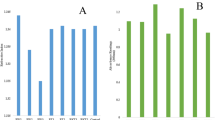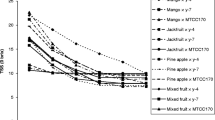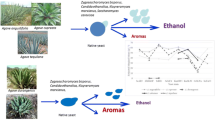Abstract
The objectives of this study were to evaluate the potential of gabiroba Campomanesia pubescens (DC) O. Berg in the production of a beverage fermented using selected and wild yeasts from indigenous fermentation, analyze the volatile compounds profile present during the process of fermentation, and evaluate the sensory quality of the final beverage produced. Throughout the process of fermentation, when Saccharomyces cerevisiae UFLA CA 1162 was inoculated, there were stable viable populations around 9 log cells ml−1. During indigenous fermentation, yeast population increased from 3.7 log CFU ml−1 to 8.1 log CFU ml−1 after 14 days. The diversity and dynamics of the yeast population during indigenous fermentation observed by PFGE analysis showed five different karyotyping profiles in the first days of fermentation. After the seventh day, there was a higher frequency of a similar S. cerevisiae profile. The yeast non-Saccharomyces were identified by sequencing of the ITS region as Candida quercitrusa and Issatchenkia terricola. Inoculated fermentations yielded a higher amount of alcohol than indigenous ones, indicating the efficiency of selected strains. There was also a greater concentration of higher alcohols, which are usually responsible for the flavor found in alcoholic beverages. Based on the characteristics of the pulp and acceptance in the sensory analysis, gabiroba fruits showed good potential for use in the production of fermented beverage.






Similar content being viewed by others
References
Akubor PI, Obio SO, Nwadomere KA, Obiomah E (2003) Production and quality evaluation of banana wine. Plant Foods Hum Nutr 58:1–6
Alves RE, Filgueiras HCA, Moura CFH (2000) In: Alves RE, Filgueiras HAC, Moura CFH (eds) Caracterização de frutas nativas da América Latina, vol 9 (Série Frutas Nativas). Jaboticabal, SP, Brazil, pp 15–18
Andrade JS, Pantoja L, Maeda RN (2003) Melhoria do rendimento e do processo de obtenção da bebida alcoólica de pupunha (Bactris gasipaes Kunth). Cienc Tecnol Alimentos 23:34–38
Association of Official Analytical Chemistry (1992) Official methods of analysis of the association of official analytical chemistry, 15th edn. AOAC, Washington
Bernardi TL, Pereira GVM, Cardoso PG, Dias ES, Schwan RF (2008) Saccharomyces cerevisiae strains associated with the production of cachaca: identification and characterization by traditional and molecular methods (PCR, PFGE and mtDNA-RFLP). World J Microbiol Biotechnol 43:2705–2712. doi:10.1007/s11274-008-9799-y
Briones AI, Ubeda J, Grando MS (1996) Differentiation of Saccharomyces cerevisiae strains isolated from fermenting musts according to their karyotype patterns. Int J Food Microbiol 28:369–377. doi:10.1016/0168-1605(95)00008-9
Buescher RW, Furmanski RJ (1978) Role of pectinesterase and polygalacturonase in the formation of woolliness in peaches. J Food Sci 43:264–266. doi:10.1111/j.1365-2621.1978.tb09788.x
Catarino S, Madeira M, Monteiro F, Rocha F, Curvelo-Garcia AS, De Sousa RC (2008) Effect of bentonite characteristics on the elemental composition of wine. J Agric Food Chem 58:158–165. doi:10.1021/jf0720180
Chanchaichaovivat A, Ruenwongsa P, Panijpan B (2007) Screening and identification of yeast strains from fruits and vegetables: potential for biological control of postharvest chilli anthracnose (Colletotrichum capsici). Biol Control 42:326–335. doi:10.1016/j.biocontrol.2007.05.016
Ciani M, Beco L, Comitini F (2006) Fermentation behaviour and metabolic interactions of multistarter wine yeast fermentations. Int J Food Microbiol 108:239–245. doi:10.1016/j.ijfoodmicro.2005.11.012
Clemente-Jimenez JM, Mingorance-Cazorla L, Martinez-Rodríguez S, Heras-Vázquez FJL, Rodríguez-Vico F (2005) Molecular characterization and oenological properties of wine yeasts isolated during spontaneous fermentation of six varieties of grape must. Food Microbiol 21:149–155. doi:10.1016/S0740-0020(03)00063-7
Dias DR, Schwan RF, Freire ES, Serôdio RS (2007) Elaboration of a fruit wine from cocoa (Theobroma cacao L.). Int J Food Sci Technol 42:319–329. doi:10.1111/j.1365-2621.2006.01226.x
Dias DR, Schwan RF, Lima LCO (2003) Metodologia para elaboração de fermentado de cajá (Spondias mombin L.). Cienc Tecnol Alimentos 23:342–350
Domizio P, Lencioni L, Ciani M, Blasi SDI, Pontremolesi C, Sabatelli MP (2007) Spontaneous and inoculated populations dynamics and their effects on organoleptic characters of Vinsanto wine under different process conditions. Int J Food Microbiol 115:281–289. doi:10.1016/j.ijfoodmicro.2006.10.052
Dunham MJ, Badrane H, Ferea T, Adams J, Brown PO, Rosenzweig F, Botstein D (2002) Characteristic genome rearrangements in experimental evolutions of Saccharomyces cerevisiae. Proc Natl Acad Sci USA 99:16144–16149. doi:10.1073/pnas.242624799
Egli CM, Edinger WD, Mitrakul CM, Henick-Kling T (1998) Dynamics of indigenous and inoculated yeast populations and their effects on the sensory character of Riesling and Chardonnay wine. J Appl Microbiol 85:779–789. doi:10.1046/j.1365-2672.1998.00521.x
Ferreira ACS, Barbe JC, Bertrand A (2002) Heterocyclic acetals from glycerol and acetaldehyde in port wines: evolution with aging. J Agric Food Chem 50:2560–2564. doi:10.1021/jf011391j
Fischer G, James SA, Roberts IN, Oliver SG, Louis ET (2000) Chromosomal evolution in Saccharomyces. Nature 405:451–453. doi:10.1038/35013058
Fleet GH (1999) micro organisms in food ecosystems. Int J Food Microbiol 50:101–117. doi:10.1016/S0168-1605(99)00080-X
Fleet GH (2003) Yeast interactions and wine flavor. Int J Food Microbiol 86:11–22. doi:10.1016/S0168-1605(03)00245-9
Garde-Cerdán T, Ancín-Azpilicueta C (2006) Contribution of wild yeasts to the formation of volatile compounds in inoculated wine fermentations. Eur Food Res Technol 222:15–25. doi:10.1007/s00217-005-0029-7
Gerbaux V, Meurgues O (1995) Influence du sulfitage et du débourbage des moûs sur l’élaboration et la qualité des vins de chardonnay. Rev Enol 78:15–18
Jemec KP, Cadez N, Zagorc T, Bubic V, Zupec A, Raspor P (2001) Yeast population dynamics in five spontaneous fermentations of Malvasia must. Food Microbiol 18:247–259. doi:10.1006/fmic.2001.0396
Jeyaram K, Singh WM, Capece A, Romano P (2008) Molecular identification of yeast species associated with ‘Hamei’—a traditional starter used for rice wine production in Manipur, India. Int J Food Microbiol 124:115–125. doi:10.1016/j.ijfoodmicro.2008.02.029
Kuthan M, Devaux F, Janderová B, Slaninova I, Jacq C, Palková Z (2003) Domestication of wild Saccharomyces cerevisiae is accompanied by changes in gene expression and colony morphology. Mol Microbiol 47:745–754. doi:10.1046/j.1365-2958.2003.03332.x
Landrum LR (1986) Campomanesia, pimenta, Blepharocalyx, Legrandia, Acca, Myrrhinium, and Luma (Myrtaceae). Flora Neotropica Monogr 45:1–179
Matsuno H, Uritani I (1972) Physiological behaviour of peroxidase isoenzymes in sweet potato root issue injured by cutting black root. Plant Cell Physiol 13:1091–1101
Mccready RM, Mccomb EA (1952) Extraction and determination total pectin material in fruits. Anal Chem 12:1586–1588
Miller GL (1959) Use of dinitrosalicylic acid reagent for determination of reducing sugar. Anal Biochem 31:426–428
Molnár O, Wuczkowski M, Prillinger H (2008) Yeast biodiversity in the guts of several pests on maize; comparison on three methods: classical isolation, cloning and DGGE. Mycol Prog 7:11–123. doi:10.1007/s11557-008-0558-0
Naumova ES, Ivannikova Yu V, Naumov GI (2004) Genetic differentiation of the sherry yeasts Saccharomyces cerevisiae. Appl Biochem Microbiol 41:578–582. doi:10.1007/s10438-005-0105-6
Nurgel C, Erten H, Canbas A, Cabaroglu T, Selli S (2002) Influence of Saccharomyces cerevisiae strain on fermentation and flavor compounds of white wines made cv. Emir grown in Central Anatolia, Turkey. J Ind Microbiol Biotechnol 29:28–33. doi:10.1038/sj.jim.7000258
Reddy LVA, Reddy OVS (2005) Production and characterization of wine from mango fruit (Mangifera indica L.). World J Microbiol Biotechnol 21:1345–1350. doi:10.1007/s11274-005-4416-9
Romano P, Brandolini V, Ansaloni C, Menziani E (1998) The production of 2, 3-butanediol as a differentiating character in wine yeasts. World J Microbiol Biotechnol 14:649–653. doi:10.1023/A:1008804801778
Romano P, Suzzi G (1996) Origin and production of acetoin during wine yeast fermentation. Appl Environ Microbiol 62:309–315
Schwan RF, Mendonça AT, Silva JJ Jr, Rodrigues V, Wheals AE (2001) Microbiology and physiology of cachaça (aguardente) fermentations. Antonie Van Leeuwenhoek 79:89–96. doi:10.1023/A:1010225117654
Santos CS, Almeida SS, Toledo AL, Santana JCC, de Souza RR (2005) Elaboração e análise sensorial do fermentado de acerola (Malpighia punicifolia L.). Braz J Food Technol 10:47–50
Schmid J, Voss E, Soll DR (1990) Computer-assisted methods for assessing strain relatedness in Candida albicans by fingerprinting with the moderately repetitive sequence Ca3. J Clin Microbiol 28:1236–1243
TACO Tabela Brasileira de Composição de Alimentos (2006) http://www.unicamp.br/nepa/taco. Accessed 5 March 2008
Valles BS, Bedriñana RP, Tascón NF, Garcia AG, Madrera RR (2005) Analytical differentiation of cider inoculated with yeast (Saccharomyces cerevisiae) isolated from Asturian (Spain) apple juice. LWT 38:455–461. doi:10.1016/j.lwt.2004.07.008
Vallilo MI, Lamardo LCA, Garbelotti ML, Oliveira E, Moreno PRH (2006) Composição química dos frutos de Campomanesia adamantium (Cambessédes) O. Berg. Cienc Tecnol Alimentos 26:805–810
Wisseman KW, Lee CY (1980) Polyphenoloxidase activity during grape maturation and wine production. Am J Enol Vitic 31:206–211
Yemm WE, Willis AJ (1954) The estimation of carbohydrates in plant extracts by anthrone. Biochem J 57:508–514
Acknowledgments
The authors thank Conselho Nacional de Desenvolvimento Científico e Tecnológico do Brasil (CNPq) and CAPES (Coordenação de Aperfeiçoamento de Pessoal de Nível Superior) for financial support and scholarships.
Author information
Authors and Affiliations
Corresponding author
Rights and permissions
About this article
Cite this article
Duarte, W.F., Dias, D.R., de Melo Pereira, G.V. et al. Indigenous and inoculated yeast fermentation of gabiroba (Campomanesia pubescens) pulp for fruit wine production. J Ind Microbiol Biotechnol 36, 557–569 (2009). https://doi.org/10.1007/s10295-009-0526-y
Received:
Accepted:
Published:
Issue Date:
DOI: https://doi.org/10.1007/s10295-009-0526-y




